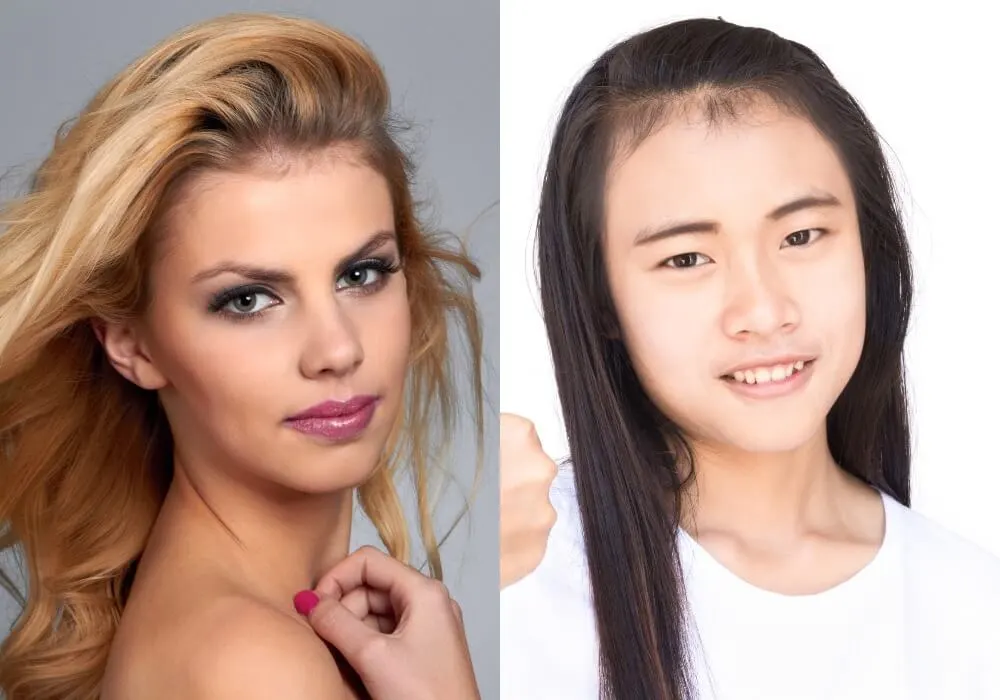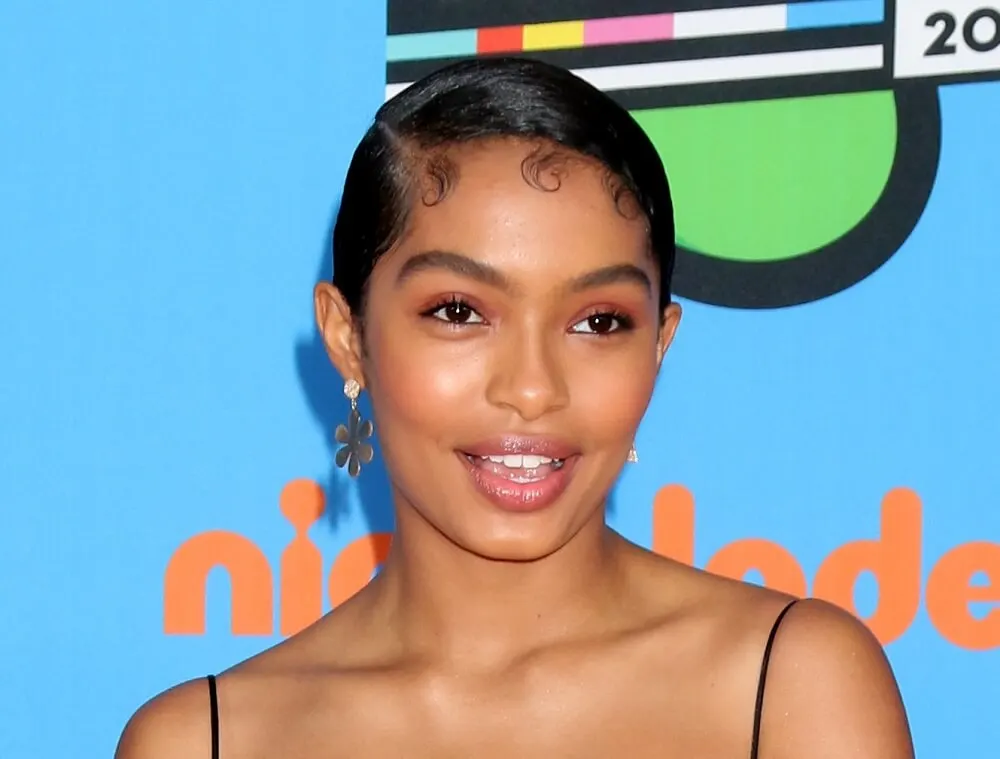If you have soft and wispy hairs that appear along your hairline, baby hairs, it’s time to make a choice. You can style them up or down, blend them into the rest of your hair (if possible) or just get rid of them. There’s no right or wrong; it’s just a matter of personal preference. Before you decide, though, let’s look at what baby hairs are.
What Causes Baby Hairs?

Baby hairs can be long, short, straight, or curly and can be just a half-inch up to three inches long. They are different from the shorter strands you get when you’ve pulled your hair into too-tight ponytails or over-processed it with color treatments or perms. Those are regular hairs that have broken off. Baby hairs are fine, like the hair on a baby.
Baby hair is genetic, but some women get them during pregnancy. Mature women can get them too, as a precursor to hair fall when their hair starts to thin.
What to Do With Your Baby Hairs?
Baby hairs are so cool. There are a few ways you can make them look trendy.
Brush Your Baby Hairs Back and Seal

If you just want a little gloss for your edges but don’t want to stand out too much, just brush them back into the rest of your hair. Use gel, an edge cream or castor oil to give them a slick look.
Jennifer Lopez isn’t the only major celebrity with a signature hairstyle enhanced by baby hair. Do an image search on Rihanna and Alicia Keys, and you’ll be sure to find photos of them flaunting their baby hairs in a way that’s not too showy.
Loop Baby Hairs Up

This is one of the most current looks to create small, thin spirals in the area that are not flat on your face. These are ultra-feminine. These are created on the sides of the head; after all you don’t want an Alfalfa sticking up in the middle.
Loop Your Baby Hairs On Your Face

This look is showy, but as they say, “If you’ve got them, flaunt them.” The style possibilities are almost endless. You can just create a curly loop near the ear if you want to go retro.
Or create a festivity of them, clockwise and counterclockwise. Or maybe you just want a wavy look that goes straight down. Play with your hair and see what expresses your personality best.
How to Keep Your Baby Hairs
Here’s where things get a little difficult. After all, baby hairs are fragile and if you play with them too much, you’re almost certain to lose them. Treating your hairline gently can help you maintain them:
- No scrubbing: Don’t scrub, scratch or vigorously wash around the hairline.
- No pulling: Really, no pulling. Avoid tight twists, braids and ponytails that tug on the hairline. And never, ever wear extensions anywhere close.
- Condition: Keep your hairline edges moistened and conditioned always.
- No heat tools: Don’t use heat styling tools on your hairline, period. Don’t do it!
- No friction: Stop wearing tight hats, headbands, or anything that cause friction in the area.
- Be careful with products: No hairspray. If you use gel or an edge cream, wash it before reapplying.
What You Need to Create Edges
Technically, when you style your baby hairs into intricate curlicue patterns that are pressed and secured against the forehead and the sides of the head, you are creating “laid edges.”
You’ll need an edge control brush (a toothbrush could work fine), some gel, pomade, or a stronghold hairspray to accomplish this artistic look. In addition, you can incorporate itty-bitty jewels or baby flowers into each curled edge for an even more elegant finish.
The below short video shows how to tame baby hairs.
Be careful with your products, though. It’s hard to find natural gel and edge creams that don’t contain carbomer or PEG (polyethylene glycol). These are petrochemicals that can lodge in your hair follicles and cause those pretty edges to fall out.
Look for natural gels and edge creams made with agave, castor oil, and flaxseed to keep your edges healthy.
Okay, Fine, Get Rid of Your Baby Hairs
If you hate your baby hairs and want it to “be gone!” Many well-known celebrities downplay (or permanently remove) their baby hairs.
Kim Kardashian made headlines some years back when she announced that she lasered her baby hairs because they caused breakouts on her forehead. (Since then, she has admitted that she sometimes misses her baby hair, but unfortunately, her choice was permanent.)
How to Get Rid of Baby Hairs (DIY)
If you don’t want to take a drastic step like laser treatments, other methods can help reduce or diminish the appearance of baby hair.
- Waxing or applying depilatory cream are less invasive hair removal options but not permanent solutions.
- Plucking or threading your baby hairs is time-consuming (and a bit painful) but could be an option if you don’t have too much of it and are not seeking a perfectly smooth, hair-free hairline.
Note: Shaving your baby hairs is a complete no-no! Not only will it cause unsightly stubble after the first day or so, but shaving will irritate the hairline, which can also lead to acne.
Related Topic: Vellus Hair Vs. Terminal Hair: What’s The Difference?
Here is a helpful video explaining how to remove baby hairs at home.
Medical solutions
When applied topically, certain medications do not reduce or eliminate baby hairs but instead encourage their growth so you can eventually incorporate them into the rest of your hair. Pursue a medical solution upon discussing the issue with a qualified medical physician, genetic specialist, or dermatologist.
Wearing haircuts with bangs and other face-framing or windswept hairstyles won’t get rid of your baby hair, but they will undoubtedly camouflage it. This is the most feasible and popular solution for most women who hate their baby hair.
FAQs
Baby hairs are the shorter, thinner, possibly frizzier or curlier strands of hair that line your face. They might also appear at the nape of your neck.
You can style them so that they are little curls that fringe your face, or lay them onto your face, pull them back with gel or get rid of them entirely.
Yes, they usually grow back, unless you laser them.
It depends on what you’ve done to them. They take two to six weeks to grow back if you’ve just plucked them away.
They will grow between a half-inch to two, sometimes three inches long.
Baby hairs are fragile and can fall out under too much manipulation.
Baby hairs can grow in as a different texture and sometimes a lighter color as well.
It depends where you live, but generally, it costs around $250 a session, and you’ll need multiple sessions. So it can run into thousands of dollars.
Not everyone has baby hairs. It’s a genetic trait.
If your baby hairs go back further than most people’s, you might have hair thinning in the area. The hair will still grow, but it comes in shorter or finer.
Not really. If you style your baby hairs they can draw more attention to a large forehead. Bangs can help a large forehead look smaller.
Yes.
Baby hairs are usually thin. If yours are thick, you might be experiencing hair breakage in the front.
If you’ve never had baby hairs before, and your hair front is thinning, yes. Sudden baby hairs could be a sign that your hair is growing thinner in diameter, which is a prelude to hair loss and balding.
You could create cute curls in the front with a little gel, depending on how long they are.
